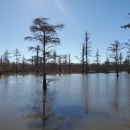About Us
Crab Orchard National Wildlife Refuge was established on August 5, 1947. The refuge is made up of 44,000 acres of land with a great diversity of flora and fauna. The major habitats on the refuge include oak hickory upland forest, bottomland hardwood forest, cropland, grazing units, brushland, prairie, wetlands and lakes. The refuge also includes a 4,050 acre congressionally designated wilderness area wilderness area
Wilderness areas are places untamed by humans. The Wilderness Act of 1964 allows Congress to designate wilderness areas for protection to ensure that America's pristine wild lands will not disappear. Wilderness areas can be part of national wildlife refuges, national parks, national forests or public lands managed by the Bureau of Land Management.
Learn more about wilderness area .
Our Mission
The mission of the National Wildlife Refuge System is to administer a national network of lands and waters for the conservation, management and, where appropriate, restoration of the fish, wildlife and plant resources and their habitats within the United States for the benefit of present and future generations of Americans.
Every national wildlife refuge national wildlife refuge
A national wildlife refuge is typically a contiguous area of land and water managed by the U.S. Fish and Wildlife Service for the conservation and, where appropriate, restoration of fish, wildlife and plant resources and their habitats for the benefit of present and future generations of Americans.
Learn more about national wildlife refuge was created for a special purpose. Some were created to protect migratory birds, others to protect threatened or endangered species, or unique habitats, while others fulfill another special purpose. All activities allowed on refuges must be evaluated to make sure each activity will not conflict with the reason the refuge was founded. Crab Orchard National Wildlife Refuge has four primary purposes.
Wildlife conservation
The refuge exists to protect, enhance and manage natural resources and the refuge landscape through an ecosystem approach that sustains optimum populations of migratory waterfowl, native fish and wildlife species and threatened and endangered wildlife.
Agriculture
The refuge seeks to provide opportunities for and encourage agricultural uses that help attain wildlife conservation goals, benefit the local economy and are compatible with other refuge purposes.
Industry
The refuge manages an industrial complex fully utilized by compatible tenants that conform to prescribed safety, health, environmental and maintenance standards.
Recreation
The refuge provides safe and equitable public use programs and facilities so that visitors have an enjoyable recreational experience and gain an appreciation for fish and wildlife resources, natural and cultural history, outdoor ethics and environmental awareness.
Our History
August 5, 1947 - The refuge was established by public law with four primary proposes that include wildlife conservation, agriculture, industry and recreation.
1956 - Annual visitation surpasses 1 million for the first time.
1966 - The first managed deer hunt is held.
1976 - Congress designated 4,050 acres as wilderness.
